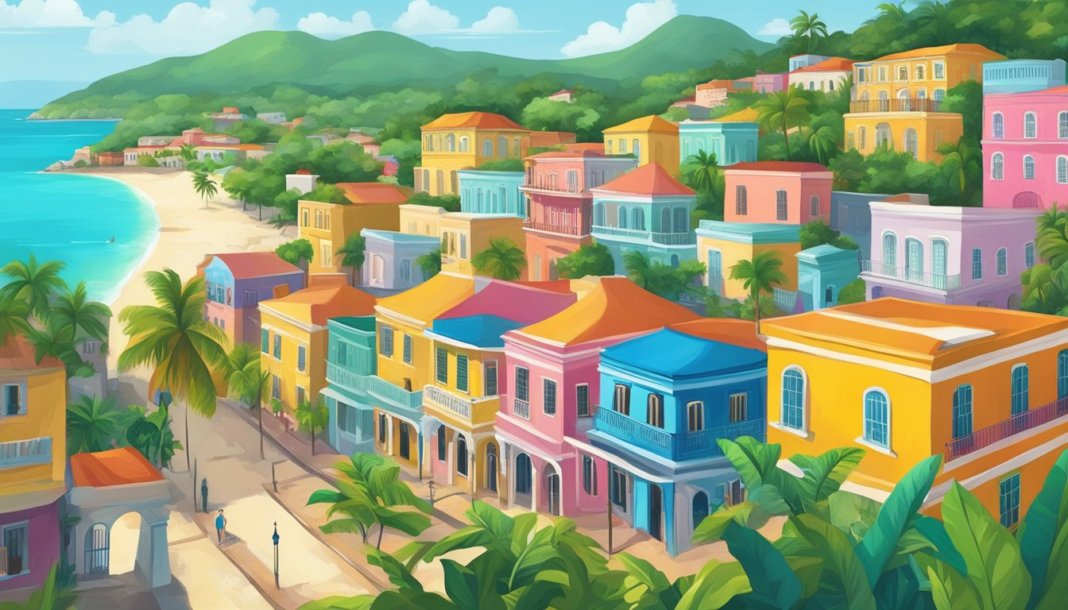The Caribbean is known for its sun-soaked beaches, turquoise waters, and vibrant culture, but it’s also home to several UNESCO World Heritage Sites that offer a deep dive into the region’s history, biodiversity, and architectural wonders.
While famous UNESCO sites like Bridgetown in Barbados and Old Havana in Cuba are well-known, there are many lesser-known UNESCO sites that showcase the Caribbean’s rich cultural heritage and natural beauty.
In this guide, we’ll explore some of the more hidden UNESCO World Heritage Sites in the Caribbean that you may not know about.
1. Brimstone Hill Fortress National Park (St. Kitts and Nevis)
Located on the island of St. Kitts, Brimstone Hill Fortress is one of the best-preserved historical fortifications in the Caribbean. This impressive fortress, built by enslaved Africans during the 17th and 18th centuries, is perched on a volcanic hill, offering stunning views of the surrounding islands and the Atlantic Ocean.
Why It’s Special:
Brimstone Hill Fortress was designated a UNESCO World Heritage Site in 1999 for its architectural grandeur and historical significance. The fortress played a crucial role in the colonial battles between the British and French for control of the Caribbean. Its well-preserved bastions, barracks, and cannons provide a fascinating glimpse into the island’s military history.
What to See:
- Fort George Citadel: The centerpiece of the fortress with panoramic views.
- Visitor Center: Exhibits detailing the construction of the fort, colonial warfare, and the role of enslaved Africans in building it.
- Hiking Trails: Explore the surrounding area with trails leading to various vantage points.
2. Morne Trois Pitons National Park (Dominica)
Morne Trois Pitons National Park is a lush, mountainous rainforest located in the heart of Dominica, often called the “Nature Island” of the Caribbean. This national park was inscribed as a UNESCO World Heritage Site in 1997 for its unique volcanic landscape and biodiversity.
Why It’s Special:
The park is home to Morne Trois Pitons, a 4,700-foot (1,400 meters) volcano, as well as Boiling Lake, the second-largest hot lake in the world. The park’s landscapes include dense rainforests, rivers, waterfalls, and volcanic fumaroles. It is a biodiversity hotspot, home to rare and endemic species like the Imperial Amazon Parrot, Dominica’s national bird.
What to See:
- Boiling Lake: A rare natural phenomenon where water in the crater of an extinct volcano is heated by geothermal activity.
- Emerald Pool: A picturesque waterfall and pool surrounded by lush greenery, perfect for swimming.
- Valley of Desolation: A unique area of volcanic activity with steam vents and boiling mud pools.
3. Historic Area of Willemstad, Inner City and Harbour (Curaçao)
The capital of Curaçao, Willemstad, is a UNESCO World Heritage Site due to its vibrant and colorful colonial architecture and its importance as a trading hub during the Dutch colonial era. Willemstad’s inner city and harbor were designated a UNESCO site in 1997.
Why It’s Special:
Willemstad is a living example of the fusion of European and Caribbean cultures, with its brightly painted houses and Dutch-style gabled roofs reflecting both local and colonial influences. The city’s waterfront, known as Handelskade, is one of the most photographed spots in the Caribbean.
What to See:
- Handelskade: The iconic waterfront lined with colorful Dutch colonial buildings.
- Queen Emma Bridge: A floating pontoon bridge that connects the two halves of Willemstad.
- Punda District: Explore the historic streets, museums, and markets of this charming neighborhood.
4. La Fortaleza and San Juan National Historic Site (Puerto Rico)
Located in San Juan, the capital of Puerto Rico, this UNESCO site includes La Fortaleza, the oldest executive mansion in continuous use in the Americas, and the surrounding historic fortifications that protected the city from sea attacks.
Why It’s Special:
La Fortaleza and San Juan’s fortifications, including Castillo San Felipe del Morro and Castillo San Cristóbal, were built by the Spanish between the 16th and 20th centuries to defend the island from pirates and rival European powers. The fortresses represent some of the finest examples of military architecture in the New World and have played a significant role in Caribbean and global history.
What to See:
- Castillo San Felipe del Morro: A six-level fortress offering stunning views of the Atlantic Ocean.
- Castillo San Cristóbal: The largest Spanish-built fort in the Americas, designed to protect the city from land invasions.
- Old San Juan: Wander the cobblestone streets of this charming historic district, filled with colorful buildings and historic landmarks.
5. Blue and John Crow Mountains (Jamaica)
Blue and John Crow Mountains National Park became a UNESCO World Heritage Site in 2015 for its natural beauty and cultural significance. The park spans Jamaica’s highest peaks and is a key cultural landscape that tells the story of the Maroons, descendants of enslaved Africans who escaped and formed independent communities in the mountains.
Why It’s Special:
The Blue Mountains are famous for producing some of the world’s finest coffee, while the park’s dense rainforests are home to unique wildlife, including the Jamaican Blackbird and the Giant Swallowtail Butterfly, the largest butterfly in the Americas. The area’s cultural significance lies in the history of the Maroons, who used the mountains as a refuge and a base for resisting colonial rule.
What to See:
- Coffee Plantations: Visit coffee farms to learn about the cultivation of Blue Mountain coffee.
- Cinchona Botanical Gardens: A historic garden with panoramic views of Kingston and the mountains.
- Hiking Trails: Trek through the lush forests to waterfalls and the peak of Blue Mountain.
6. Pitons Management Area (Saint Lucia)
The Pitons Management Area, located on the southwest coast of Saint Lucia, was designated a UNESCO World Heritage Site in 2004. This area is named after the Gros Piton and Petit Piton, two iconic volcanic spires that rise dramatically from the Caribbean Sea.
Why It’s Special:
The Pitons are among the most recognizable landmarks in the Caribbean, symbolizing the island’s volcanic origins. The surrounding area is a biodiversity hotspot with coral reefs, tropical forests, and geothermal activity, including hot springs and fumaroles. The Pitons are also a major attraction for hikers and divers.
What to See:
- Gros Piton: Hike to the summit for breathtaking views of the island and the sea.
- Sulphur Springs: Explore the world’s only “drive-in volcano” and bathe in natural hot springs.
- Coral Reefs: Snorkel or dive along the coral reefs at the base of the Pitons to discover vibrant marine life.
7. Alejandro de Humboldt National Park (Cuba)
Named after the famous naturalist Alexander von Humboldt, this national park in eastern Cuba was declared a UNESCO World Heritage Site in 2001 due to its exceptional biodiversity. It is one of the most important conservation areas in the Caribbean.
Why It’s Special:
Alejandro de Humboldt National Park contains some of the most intact tropical forests and mountain ecosystems in the Caribbean. The park is home to many endemic species, including the Cuban solenodon, a rare mammal found only in Cuba, and the world’s smallest bird, the bee hummingbird.
What to See:
- Endemic Wildlife: Spot rare species like the Cuban parrot and the endangered Cuban crocodile.
- Hiking Trails: Explore the park’s lush forests, rivers, and waterfalls, with guided tours available for wildlife spotting.
- Botanical Diversity: The park is rich in plant species, with many endemic orchids and palms.
Conclusion
While the Caribbean is often seen as a paradise for beach lovers, its UNESCO World Heritage Sites reveal a deeper layer of cultural and natural history that makes the region even more fascinating. Whether you’re exploring ancient fortresses, hiking through rainforests, or marveling at volcanic peaks, these lesser-known UNESCO sites offer a chance to experience the rich heritage and biodiversity of the Caribbean in a unique and meaningful way.
FAQ
What is a UNESCO World Heritage Site?
A UNESCO World Heritage Site is a location recognized by the United Nations Educational, Scientific, and Cultural Organization (UNESCO) for its outstanding cultural, historical, or natural significance.
How many UNESCO sites are there in the Caribbean?
There are currently over a dozen UNESCO World Heritage Sites in the Caribbean, each representing a unique aspect of the region’s history, culture, or natural environment.
Can I visit these UNESCO sites?
Yes, most UNESCO World Heritage Sites in the Caribbean are open to the public and can be explored through guided tours, hiking trails, or self-guided visits.
Are there any UNESCO marine sites in the Caribbean?
Yes, the Exuma Cays Land and Sea Park in the Bahamas and the marine ecosystems around the Pitons Management Area in Saint Lucia are examples of marine sites in the Caribbean.
What is the best time to visit these UNESCO sites?
The best time to visit is typically during the dry season, which runs from December to April in most parts of the Caribbean. This is when weather conditions are most favorable for outdoor activities like hiking and exploring historical landmarks.

